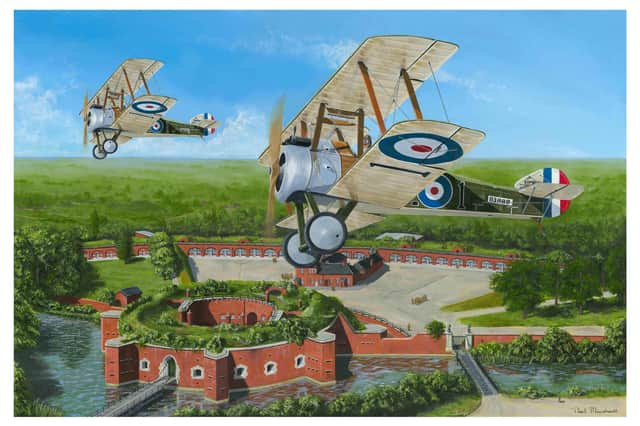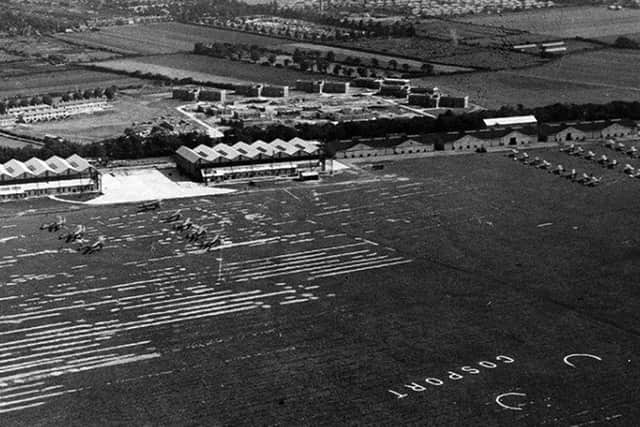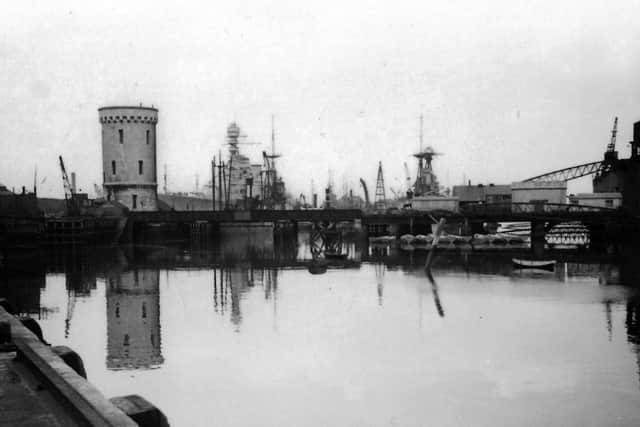Sopwith Camel Biplanes take flight at Fort Grange Airfield | Nostalgia


Below is Fort Brockhurst in Gosport with a pair of Sopwith Camel Biplanes banking overhead on their approach to land at Fort Grange Airfield nearby. The scene is set in 1917.
Grange airfield was a major base for the forerunner of the RAF, the RFC (Royal Flying Corps). It’s famous for the development of the ‘Gosport Tube’ which was still in use worldwide until the 1950s. The tube allowed the trainer in the rear of the cockpit to communicate with the trainee pilot without being ‘drowned out’ by the noise of the engine.
Go to neilmarshallart.co.uk or call him on 07469711700.


Advertisement
Hide AdAdvertisement
Hide Ad:: In February 1914, Fort Grange airfield was first used by the Royal Flying Corps (RFC) on July 6. It appears they only remained for a few weeks until the Royal Naval Air Service (RNAS), a forerunner to the Fleet Air Arm, arrived in October 1914 remaining for three months or so.
In August 1945 the base was transferred to the navy becoming HMS Siskin. The navy remained in control until its closure in May 1956.
Sadly, most of the former airfield is under modern housing. These are used by the Royal Naval Air Engineering and Survival School of HMS Sultan. Thanks to the Gosport website for abridged information.
:: I published this photograph of a scene within Portsmouth Dockyard on June 10. I was inundated so thank you one and all.


Advertisement
Hide AdAdvertisement
Hide AdRobert James said he believed it to be No 3 Basin up by Fountain Lake Jetty and where the Round Tower is situated. To the right is the Floating Dock that would put the date pre-war as the dock was towed away to Malta on June 24, 1939. The Jetty that the dock used was in Fountain Lake.
Andy August said the bridge ran from the tower out to the floating Dock AFD 11.The fighting top of ship seen is of the battle-cruiser HMS Renown laid up in number 3 basin. She was later sunk by the Japanese in 1941.
Brian Jenkins says the photograph is of Flathouse Quay and not actually within the dockyard. When he was a kid, he and his brother used to row out from Rudmore Quay and fish alongside the floating bridge.
Lionel Smith told me the photo was taken from Flathouse Quay, part of which is visible in the lower left.
Advertisement
Hide AdAdvertisement
Hide AdThe quay is still there although considerably redeveloped as part of the ‘PIP’. Previously it could be accessed from Prospect Road which also disappeared in the redevelopment. The ship is either HMS Repulse or HMS Renown which were designated 'battle-cruisers'.